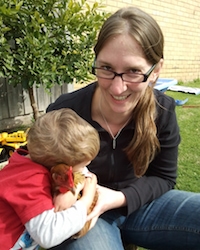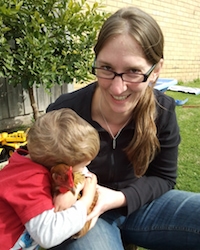Synaesthesia involves the curious experience of a sensation in one domain that is triggered by a sensation in another domain. It is surprisingly common – up to 1 in 23 will experience some type of synaesthesia, with the most common being the experience of colour for days of the week, followed by the experience of colour for letters (“grapheme-colour”).
Synaesthetes and non-synaesthetes alike tend to associate certain sounds with colours or shapes (e.g., “low” vowels or low-pitched sounds with dark colours). A group of researchers recently found that chimpanzees in Kyoto University’s primate Research Institute also spontaneously associate high-pitched sounds with light colour and low-pitched sounds with darkness (Ludwig, et al. 2011). This study showed, for the first time, that these “synaesthetic” associations were not necessarily a phenomenon related to language or even specific to humans.
What I’d love to see is whether animals – especially chimps or macaques – might experience the more poorly understood synaesthetic touch or synaesthetic pain. That is, feeling touch or pain when they see another animal or person experience the same sensation.
Mirror neuron systems have been speculated to be involved in the experience of synaesthetic touch. Mirror neurons were first discovered in monkeys, by chance, when Giacomo Rizzolatti and his colleagues were studying specific neurons in the brain involved in controlling hand and mouth actions. Low and behold, they found that the same neurons were active not only when the wired-up monkey reached out to grab a cup, but also when it watched another monkey or the experimenters reach out and grab a cup.
One study by Jamie Ward’s group at the University of Sussex found similar patterns of brain activity between their human touch synaesthete and non-synaesthetes, only the synaesthete’s activation of brain regions that process sensation appeared to exceed the threshold for actual perception of touch (Blakemore, et al. 2005). Empathy may also play a role, although from my own research the jury is still out about if and how empathy is involved (Giummarra & Moseley 2011).
So animals have mirror neurons. Some animals, like dolphins and elephants, even seem to have empathy and experience grief. So why shouldn’t they experience pain or touch when they see others experience those sensations, just as some people do.
At the end of the day, this type of synaesthesia is a whole new level of thinking about the “body in the mind”. You might even describe it as “your body in my mind in my body”. Or maybe we should call it “your body in your mind in my mind in my body” if empathy really does play a role in synaesthetic touch and pain. But perhaps that is just getting ridiculous.
About Melita Giummarra
 Melita is a research fellow at Monash University in Melbourne, soon to start on an NHMRC clinical early career fellowship. Not only did Melita just finish her PhD (at Monash University) in 2011 with a big pile of publications, she also threw a couple of babies into the mix. Melita’s post-doc research will try to disentangle the relationship between the body, mind, pain and empathy/others. Clearly, Melita is proof that a Bachelor of Arts qualifies you for much more than burger flipping.
Melita is a research fellow at Monash University in Melbourne, soon to start on an NHMRC clinical early career fellowship. Not only did Melita just finish her PhD (at Monash University) in 2011 with a big pile of publications, she also threw a couple of babies into the mix. Melita’s post-doc research will try to disentangle the relationship between the body, mind, pain and empathy/others. Clearly, Melita is proof that a Bachelor of Arts qualifies you for much more than burger flipping.
References
Blakemore SJ, Bristow D, Bird G, Frith C, & Ward J (2005). Somatosensory activations during the observation of touch and a case of vision-touch synaesthesia. Brain 128(7), 1571-83 PMID: 15817510
Giummarra MJ, & Moseley GL (2011). Phantom limb pain and bodily awareness: current concepts and future directions. Curr Opin Anaesthesiol, 24 (5), 524-31 PMID: 21772144
Ludwig VU, Adachi I, & Matsuzawa T (2011). Visuoauditory mappings between high luminance and high pitch are shared by chimpanzees (Pan troglodytes) and humans. Proceedings of the National Academy of Sciences PMID: 22143791




